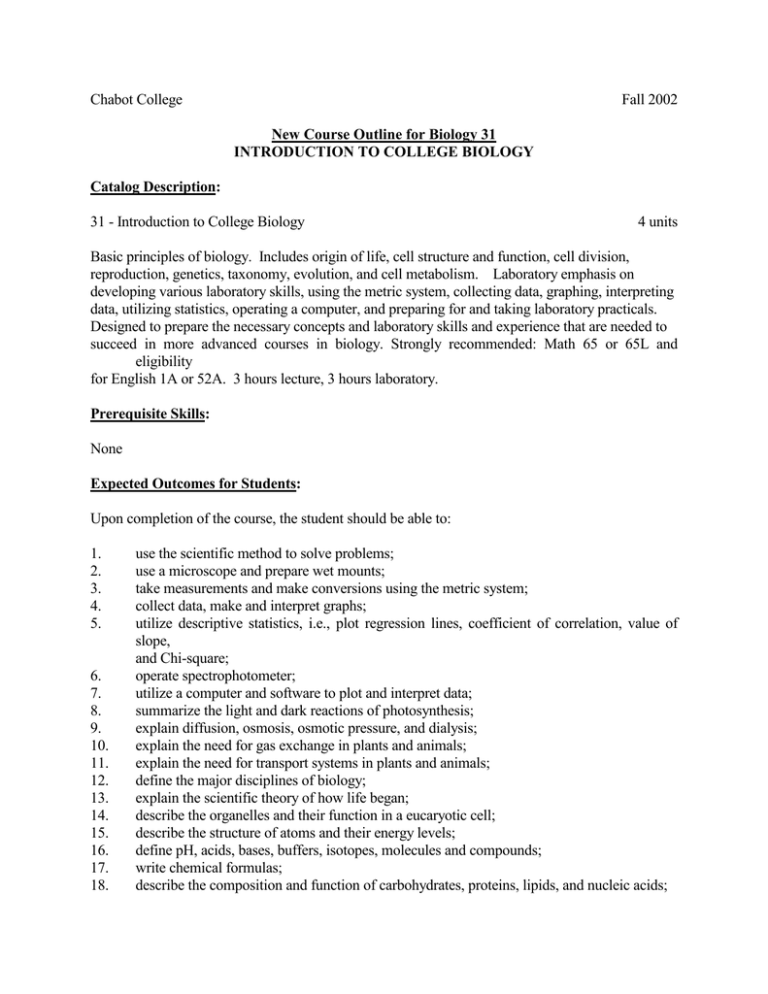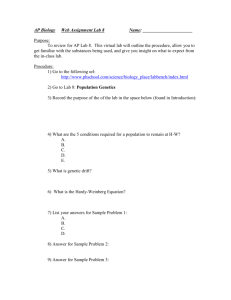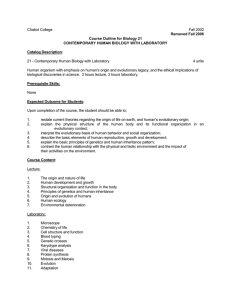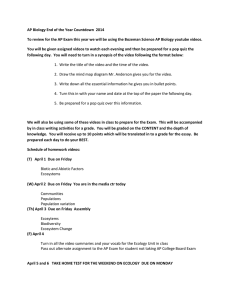Chabot College Fall 2002 31 - Introduction to College Biology
advertisement

Chabot College Fall 2002 New Course Outline for Biology 31 INTRODUCTION TO COLLEGE BIOLOGY Catalog Description: 31 - Introduction to College Biology 4 units Basic principles of biology. Includes origin of life, cell structure and function, cell division, reproduction, genetics, taxonomy, evolution, and cell metabolism. Laboratory emphasis on developing various laboratory skills, using the metric system, collecting data, graphing, interpreting data, utilizing statistics, operating a computer, and preparing for and taking laboratory practicals. Designed to prepare the necessary concepts and laboratory skills and experience that are needed to succeed in more advanced courses in biology. Strongly recommended: Math 65 or 65L and eligibility for English 1A or 52A. 3 hours lecture, 3 hours laboratory. Prerequisite Skills: None Expected Outcomes for Students: Upon completion of the course, the student should be able to: 1. 2. 3. 4. 5. 6. 7. 8. 9. 10. 11. 12. 13. 14. 15. 16. 17. 18. use the scientific method to solve problems; use a microscope and prepare wet mounts; take measurements and make conversions using the metric system; collect data, make and interpret graphs; utilize descriptive statistics, i.e., plot regression lines, coefficient of correlation, value of slope, and Chi-square; operate spectrophotometer; utilize a computer and software to plot and interpret data; summarize the light and dark reactions of photosynthesis; explain diffusion, osmosis, osmotic pressure, and dialysis; explain the need for gas exchange in plants and animals; explain the need for transport systems in plants and animals; define the major disciplines of biology; explain the scientific theory of how life began; describe the organelles and their function in a eucaryotic cell; describe the structure of atoms and their energy levels; define pH, acids, bases, buffers, isotopes, molecules and compounds; write chemical formulas; describe the composition and function of carbohydrates, proteins, lipids, and nucleic acids; 19. describe the stages of mitosis and meiosis; Chabot College Course Outline for Biology 31, page 2 Expected Outcomes for Students (continued) 20. 21. 22. 23. 24. 25. 26. 27. solve monohybrid, dihybrid, sex-linked, and multiple allele problems; write scientific names correctly; describe the relationships between taxa; explain the major concepts of Darwin's theory of evolution; explain the application of the Hardy-Weinberg Law; describe the modern theory of evolution; define autotroph, heterotroph, aerobic and anaerobic respiration; define and interrelate the ecological concepts of trophic levels, food webs, energy flow, nutrient cycles, and ecosystems. Course Content (Lecture): 1. 2. 3. 4. 5. Introduction to biology a. Disciplines b. Terminology c. Characteristics of life d. Levels of organization Scientific method and attitudes a. Definitions of terms b. Steps in using the scientific method c. Flow of scientific knowledge Introduction to inorganic chemistry a. Elements, atoms, ions, molecules, atomic structure, oxidation number b. Ionic, covalent, and hydrogen bonding c. Acids, bases, buffers d. pH scale e. Isotopes Introduction to organic chemistry a. Structural and chemical formulas b. Carbohydrates c. Proteins d. Lipids e. Nucleic acids Origin of life a. Primitive earth b. Miller, Fox experiments c. d. Coacervate theory Autotrophy and heterotrophy Chabot College Course Outline for Biology 31, page 3 Course Content (Lecture) - continued 6. 7. 8. 9. 10. 11. 12. 13. Study of the cell a. History of cell theory b. Basic structure and function of organelles c. Today's concept of the cell d. Differences between plant and animal cells e. DNA replication f. Function of rRNA, tRNA, mRNA in protein synthesis Cell division a. Mitosis b. Meiosis (oogenesis, spermatogenesis) Reproduction a. Asexual methods, i.e., binary fission, budding, fragmentation, parthenogenesis, and sporulation b. Sexual methods c. Alternation of generations Development a. Fertilization and cleavage b. Morula, blastula, and gastrula c. Ectoderm, mesoderm, and endoderm d. Formation of the neural tube and digestive tract Classical genetics a. Mendelian genetics b. Monohybrid, dihybrid, test and sex-linked, multiple alleles, incomplete dominance, and test crossing Taxonomy a. Binomial system b. Writing scientific names c. Relationship of taxa Evolution a. Darwin's theory b. Modern theory of evolution c. Hardy-Weinberg Law d. Methods of Selection Cellular metabolism a. Highlights and significance of anaerobic and aerobic respiration, i.e., glycolysis, pyruvic b. acid oxidation, Kreb's cycle, and oxidative phosphorylation Highlights and significance of photosynthesis, i.e., photosystem I and II, light and dark reactions Chabot College Course Outline for Biology 31, page 4 Course Content (Lecture) - Continued: 14. Principles of Ecology a. Trophic levels b. Food chain and web c. Flow of Energy d. Nutrient cycles Course Content (Laboratory): 1. 2. 3. 4. 5. 6. 7. 8. 9. 10. 11. 12. 13. 14. 15. 16. Scientific method Measurements Microscope Plotting and graphing Descriptive statistics Using the computer and software Spectrophotometry Movement of materials Cell division: Mitosis and Meiosis Photosynthesis Respiration Acquiring Nutrients and Enzyme Action Transport Systems Disposal of Wastes and Regulation of Body Fluids Applied Genetics Taxonomy Methods of Presentation: 1. 2. 3. Lecture and discussion Laboratory exercises Multimedia presentations Chabot College Course Outline for Biology 31, page 5 Assignments and Methods of Evaluating Student Progress: 1. Typical Assignments a. Quiz before labs b. Codon worksheet c. Genetics problems 2. Methods of Evaluating Student Progress a. Midterms and quizzes b. Laboratory practicals c. Laboratory reports d. Final examination Textbook(s) (Typical): Biology, Concepts and Applications, Starr, Brooks and Cole Publisher, 4th ed., 2000 Laboratory Exercises in Biology, Collins, 2000 Special Student Materials: None Revised 2/6/02





